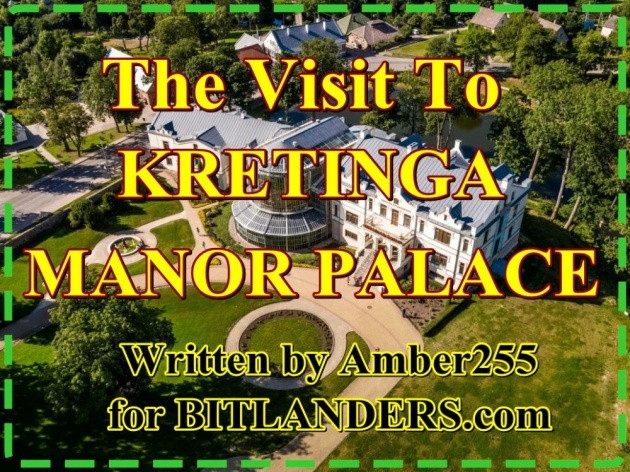
The Visit to Kretinga Manor Palace - Photo credit: Amber255 via Bitlanders.com
Greetings to all my readers. It happened so, that I started the introduction of Lithuania blog series, and had a chance to visit one of the Lithuanian Manors. Last weekend, Saturday, was my grandmother's anniversary. The decision of the family was to invite her to the birthday festive dinner. We chose the nice place - Kretinga Manor Palace. This palace now consists of the cafe, museum, and Winter Garden. We wanted a nice place not only for our festive dinner but also a nice background for our family photos, and place that our grandmother still had not seen before. Our family is enough big: a grandmother has four daughters, and all of them have two adult already children, and almost everyone is married too, and have a child or two. So, the big family dinner was arranged in the Kretinga Manor Palace.
It was the occasion, when the whole family gathered together, even those who are living abroad, came to greet our grandmother. But I do not want to write about our celebration, I want to introduce this beautiful place - Kretinga Manor Palace, and what anyone can find coming there.
Kretinga Manor Palace - Video credit: Amber255 via Bitlanders.com
The History of Kretinga Manor Palace
Kretinga Manor has been known since the 16th century. In 1875, the Graph Joseph Tyszkiewicz bought the mansion, reconstructed the palace, and arranged a greenhouse. There have been founded the Winter Garden. It boasted palm trees, grown banana trees, cacti, orange trees, laurels, citrus trees, a huge Araucaria, and bindweeds climbed the coral-shaped walls. A waterfall fell down the rocks, whose water flowed into small ponds. Ornamental fishes dived in the water, and a high fountain spurted from one pond. In 1912, the Graph Alexander Tyszkiewicz rebuilt and reduced the winter garden. After the reconstruction of the garden, the new rare plants were planted, which were carefully cared for. The winter garden was part of the interior of the palace, which connected the representative halls with the Graph's apartments.
The Winter Garden of Kretinga Manor was the largest of the greenhouse buildings in the European private estates at that time.
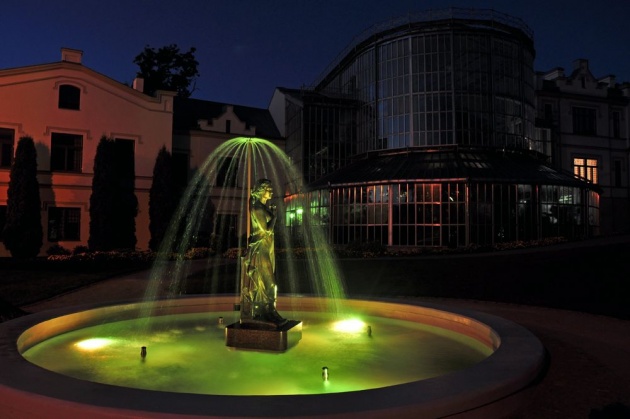
Sculpture in Kretinga Manor Park - Photo credit: kretingosenciklopedija.lt
Unfortunately, the misfortunes did not pass by this unique beautiful corner. In 1915, the winter garden suffered from a fire, and in 1940, the Red Army settled in the palace and destroyed all the plants. In the post-war years, the premises of the garden were converted into farm stables, a warehouse, a school gym, a greenhouse.
In 1987, there were completed the renovation works of the winter garden. In 1991, according to the resolution of the Government of the Republic of Lithuania, the Tyszkiewicz Palace was transferred to the Kretinga Museum. The employees of the Museum continued the work: newly redesigned expositions and purchased rare plants.
While reading my blog about Kretinga Manor Palace, please check Querlo chat:
Winter Garden of Kretinga Manor
I have been there before, so the beauty of the Winter Garden was not a surprise to me. But some members of our family visited this place the first time, and between them was our grandmother. She was happy to see so many exotic plans as she has a big garden at home and very loves indoor plants too. On the second floor, you can walk around the whole garden, and look to the first floor flowers, fountains from the above. Especially happy were our little family members as they had enough place where to run and play.
Visitors can get acquainted with the plants that came to the Winter Garden from the distant corners of the globe. These plants are small but alive witnesses in the Indian, Indonesian, Brazilian tropical forests, African and Mexican deserts. In the Winter Garden, on a live plants map, you can see how the creative human imagination was embodied, how the northern plants are grown in distant deserts or tropical forests.
The subtropical plants that are accustomed to the shining sun feel worse in the winter time. They are suffering in the cold weather, they grow up stretched, but spring is recovering them again. Such plants do not usually bloom at all, or blooms but do not produce fruits.
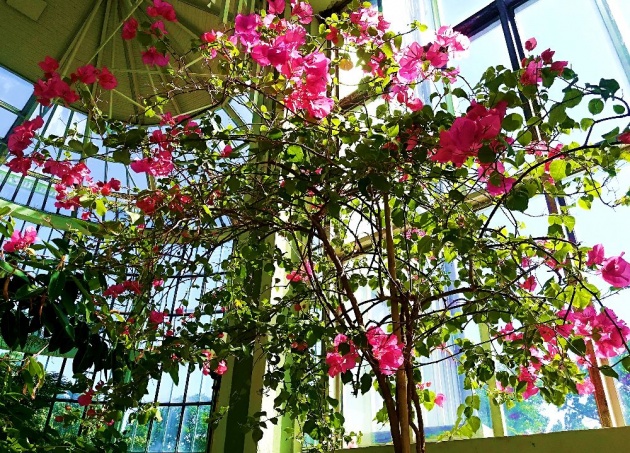
Kretinga Winter Garden, Second Floor - Photo credit: Amber255 via Bitlanders.com
At the moment, in the Winter Garden, grow over 170 species of about 5000 units of plants. The most numerous collections are Ampel plants, succulents, Epiphytes, representatives of the Dracaena, and the silk family plants. In the Winter Garden basin, there are growing water lilies among which the brightly colored Japanese carps are sailing.
Near the cascade of the water grows the Cyrtomium falcatum, Adiantum, Monstera deliciosa, and other plants. Between the cactus, like a hedgehog, the Echinocactus grusonii, the cactus, called the Queen of the Night, is famous for the world's most beautiful ring.
Credit: Amber255
On the second floor of the Winter Garden, all the tropical heat, and pleasant moisture has flooded. There are sparkling the leaves of the bright red roses, Fuchsia, Euphorbia pulcherrima, and other tropical plants.
The Winter Garden is a great home for the family of turtles and the rainbow-colored parrot Barbora, donated by the nature lovers to the Winter Garden.
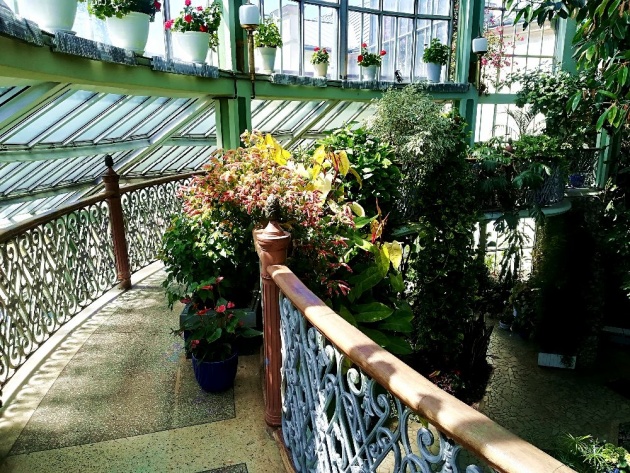
Kretinga Winter Garden - Photo credit: Amber255 via Bitlanders.com
Kretinga Museum
Kretinga and its surroundings have long been famous for the abundance of archaeological and folk architecture's monuments, ethnographic and folk art treasures, ancient folk traditions and customs, and talented folk artists. Researchers and ancient amateurs began to be interested in the Kretinga past, its monuments, the material and spiritual values of the culture in the 19th century already. Collected values found its place in the museums of St. Petersburg, Berlin, Vilnius, Tartu, Liepaja, and other cities.
During the war, the Kretinga museum was closed. After the war, the museum's director repaired the museum abandoned during the war, erected a storage facility for exhibits, prepared the first exhibitions. A great deal of attention was paid at that time to the study of folk architecture. The collected material was subsequently used to include the described old farmsteads in the lists of rural cultural monuments, thus preserving them from destruction.
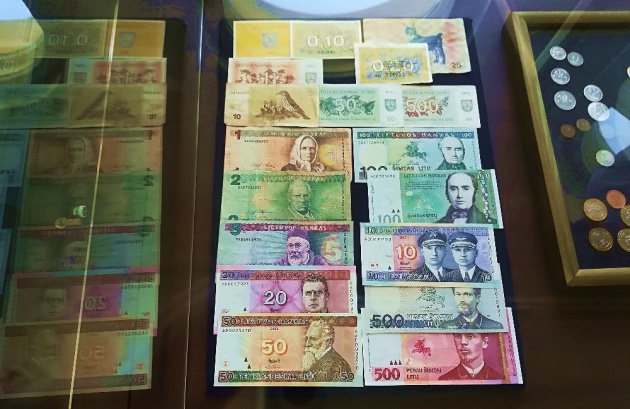
Lithuanian Money History in the Museum Exposition - Photo credit: Amber255 via Bitlanders.com
Later, the museum moved to the restored monastery's premises. After the restoration of statehood, the monastery was returned to the Franciscans, and the Kretinga Museum decided to evict to the Tyszkiewicz Palace. A new stage in the development of the museum has begun, related to the adaptation of new premises to expositions, fund repositories, the creation of new expositions, and the change in the structure of the museum.
Now, the exhibitions, cultural events, educational activities, excursions are being organized here. Also, there are three outdoor exhibitions in the Kretinga Manor Park: the Astronomical calendar with the Sun Clock in the manor park, the Memory Trail in the courtyard of the palace, and the tree sculptures in the courtyard of the houseman's house. And the Traditional Craft Center is open for visitors and offer various educational programs.
We had not much time to walk around all exhibitions presented there, just looked into couple rooms. We came here for the celebration, not for exploring the museum, so I got only the very little impressions about the museum. But it looks like there is what to see, so may I will come back there, especially when there is a great park to take a walk too.
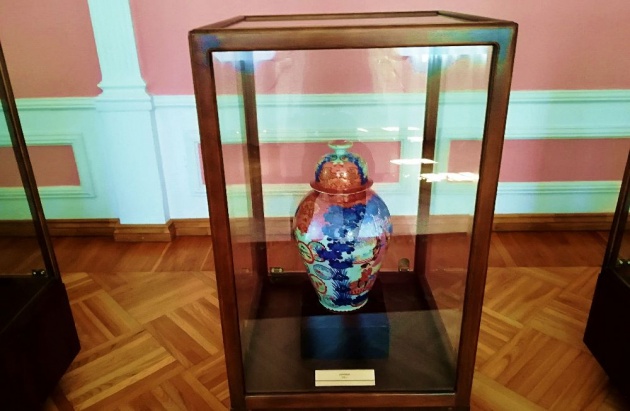
Kretinga Museum Exposition - Photo credit: Amber255 via Bitlanders.com
Kretinga Manor Park
The Kretinga Manor Park is a mixed-style park with an area of 23 ha. The start was given by a huge orchard. Later, the Graph, who managed the manor, founded a park (English style). When the estate was acquired by Graph Joseph Tyszkiewicz, being a rich, active and intelligent man, he reconstructed the manor palace, installed the famous Winter Garden, and started renovating the park.
According to the plans, the park's representative part in front of the palace was reorganized: formed the French-style geometric flower beds decorated with fountains with sculptures, trees planted next to them, and ornamental shrubs, arch-shaped tunnels of the Linden trees.
The alleys joined the park with the orchard. At their intersection, there were well-lit lounges, trails with small pebbles. The park from the street's side was separated by the stone wall and a newly masonry brick fence. On the outskirts of the Summer Garden, there was a chestnut alley.
Kretinga Manor Park - Video credit: efxlt via Youtube.com
Three cascade ponds with a waterfall, arbor were installed there. A hill was made for a pond and manor overview, and the chestnut was planted on top of it. A spiral-mounted track led down the hill. Two huge stones - benches - were built on the banks of the pond. One of them, who is above the waterfall, has been named from ancient times as the Stone of Love.
The park got a general name - Summer Garden. It was like a counterbalance to the Winter Garden. The layout of the park, rare plants, elements of small architecture, and the flowers of the exotic lands that flourished in the Winter Garden, attracted guests from all over the world.
During the war and in the post-war years, the park was severely affected. After the war, the park was declared as a natural monument protected by country, and a bit later, it was announced as a cultural heritage of the Republic of Lithuania. Today, the Kretinga Museum continues the traditions of GraphTyszkiewicz, nurtures the spaces of the park and seeks to adapt it to people's knowledge and rest. Sightseeing tours, events, concerts of classical music, exhibitions of floristic works are organized in the park. As an educational program, there are celebrated calendar holidays in the park.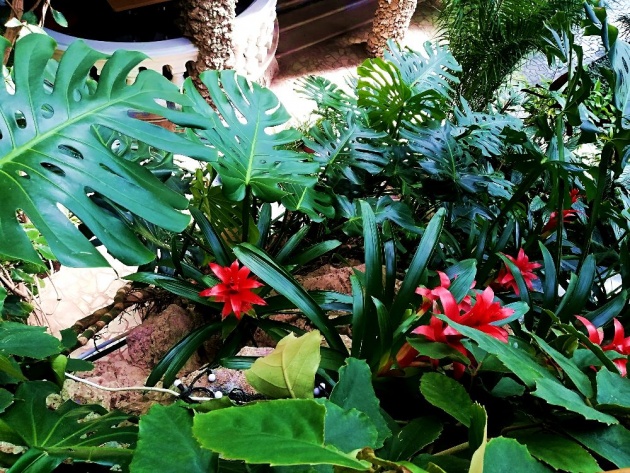
Kretinga Manor Park - Photo credit: Amber255 via Bitlanders.com
The Kretinga Manor Park is still a favorite place of the citizens, and the park is also visited by numerous tourists, coming from the foreign countries, and our own country. It's a shame that I am living so close to this place, having been in Winter Garden a couple times, but still never fully explored this big nice park. Of course, it is better to do it in warm weather, not in winter time, as there are many blooming trees, shrubs, and flower beds. The sculptures worth another look also.
Cafe in Kretinga Winter Garden
Since 1993, there is a cafe in Kretinga Winter Garden - TO GRAPH, where visitors can also find a menu corresponding to the manor's life.
Cafe TO GRAPH is famous for the delicious food, more than twenty years of customer service tradition, and a unique environment. The air inside is refreshing even on the hottest summer days, the cozy flowers and greenery are delighting even in the very middle of the winter as they are located in the only Winter Garden in Lithuania.
When the name of the newly established cafe was chosen, there was no doubt that the name should reflect the local singularity. Remembering the past of the Winter Garden, when the Graph Tyszkiewicz was making feasts with its guests, the cafe was named TO GRAPH.
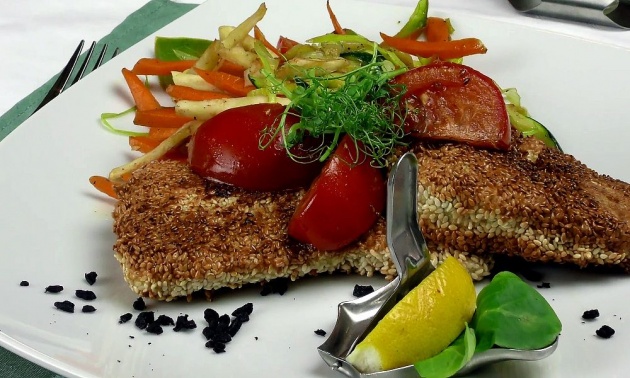
The Turkey Meat - Photo credit: Amber255 via Bitlanders.com
The name obliges the staff of the cafe to offer their visitors a menu corresponding to the manor's life. Among their dishes - snail snacks, royal shrimp, stuffed pike and other fishes, fried ham, various types of salads, steaks, baked goods. Their branded dishes are Graph's and Graph's lady steaks.
Here are musical evenings, where famous artists from the country perform. Restaurant organizes the banquets, receptions, business lunches, parties, birthdays, family celebrations, wedding feasts.
I can confirm that the food on our festive table was awesome, the service was also awesome, no complaints here. The acoustics on the second floor where is a cafe is great. Kindest regards to the staff of the cafe. We do not regret having chosen this place for the celebration of our grandmother's anniversary.
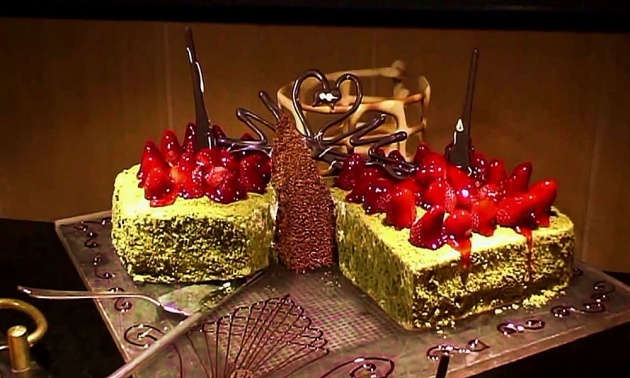
The Cake for Our Celebration - Photo Credit: Amber255 via Bitlanders.com
At the Final Note
The Graph Tyszkiewicz Manor in Kretinga is undergoing a real Renaissance. For more than two decades, the Tyszkiewicz Palace has been the home of the Kretinga Museum. It cared not only to restore the historical manor buildings but also fosters the Tyszkiewicz traditions, carefully cares about the park and restores its most valuable elements. The Kretinga Manor collects the history of the city and the whole region, also the traditional festivals are organized there, visitors are invited to sightseeing excursions and very attractive educational activities.
The Winter Garden earned the popularity of the society in all seasons. The cute cafe TO GRAPH in the romantic environment invites visitors to try their delicious dishes or just to have a cup of coffee with a cake.
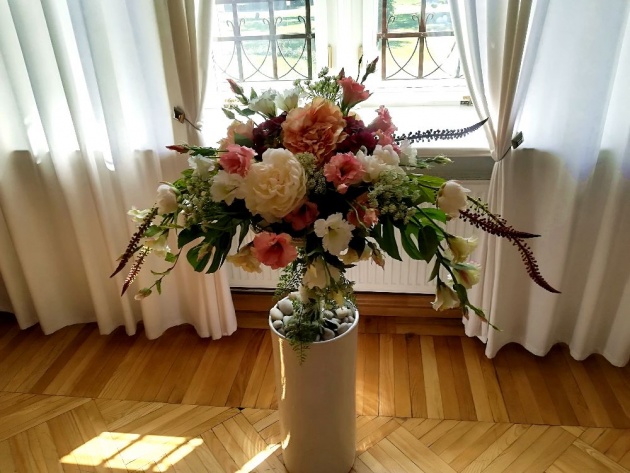
The Flowers Bouquet in one of the Palace rooms - Photo credit: Amber255 via Bitlanders.com
In the Winter Garden, you will have an eternal summer, beautiful and exotic plants, an unforgettable environment, music, a murmur of water, a cup of flavored coffee.
Is it worth visiting Kretinga Manor Palace? Definitely, yes. It is only one such Winter Garden in Lithuania, and it really has what to offer to its visitors. Our grandmother was happy to see this place, to try dishes of the Graphs, to admire exotic plants and flowers. I know, there are better and greater Winter Gardens in the world, but I am happy that our little country can offer one to us too.
***************************************************************************************************
Thank you for stopping by and reading my blog.
2018, All Rights Reserved.
You are very welcome to join Bitlanders and share your valuable knowledge and opinion.
***************************************************************************************************
You can check my other blog about Lithuania:
1. Introduction of Lithuania: Most Famous Museums
2. Introduction of Lithuania: Most Famous Lithuanian Castles
3. Introduction of Lithuania: Most Famous Manors and Palaces
4. Introduction of Lithuania: The Most Beautiful Churches
Come back to find more...
**************************************************************************************************



